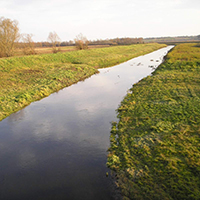Odonata assemblages in anthropogenically impacted lotic habitats

Accepted: 7 October 2020
Supplementary: 134
HTML: 36
All claims expressed in this article are solely those of the authors and do not necessarily represent those of their affiliated organizations, or those of the publisher, the editors and the reviewers. Any product that may be evaluated in this article or claim that may be made by its manufacturer is not guaranteed or endorsed by the publisher.
Authors
Increasing human pressures have a negative impact on freshwater habitats and their biota worldwide. To protect habitats and the species contained within them, ecological assessments over a gradient of near natural to degraded freshwater habitats are essential. Odonata assemblages were investigated at 46 study sites in Croatia encompassing slightly to heavily modified lowland rivers and streams. Nymphs were sampled between April and September 2016 using a benthos hand net. A total of 19 species was recorded, and Ischnura elegans (Vander Linden, 1820) and Platycnemis pennipes (Pallas, 1771) were most frequently recorded. RDA analysis indicated that water pollution (i.e. levels of chemical oxygen demand and total organic carbon), water temperature and oxygen concentration had the highest influence in the formation of Odonata assemblages at a specific habitat, reflecting their widely recognized bioindicator properties. This study showed that degraded lowland rivers can provide habitat for a relatively low number of species with broad ecological tolerance, while rare and specialist species are generally not able to reproduce there. These results contribute to our knowledge of Odonata occurrence in anthropogenically impacted habitats, and their relationships with such degraded environment.
Edited by
Federico Marrone, Department of Biological, Chemical, and Pharmaceutical Sciences and Technologies, University of Palermo, ItalyHow to Cite

This work is licensed under a Creative Commons Attribution-NonCommercial 4.0 International License.
-
Iva Vidaković Maoduš, Ivana Pozojević, Marina Vilenica, Zlatko MihaljevićInternational Journal of Limnology : 2022
-
Lucas Pereira-Moura, Carolina Gomes Viana, Leandro Juen, Sheyla Regina Marques CouceiroScience of The Total Environment : 2024
-
Tommaso Cancellario, Rafael Miranda, Enrique Baquero, Diego Fontaneto, Alejandro Martínez, Stefano Mammolanpj Biodiversity : 2022
-
Marina Vilenica, Zlatko MihaljevićWater : 2022
-
Rassim Khelifa, Hayat Mahdjoub, Affef Baaloudj, Robert A. Cannings, Michael J. SamwaysInsects : 2021
-
Kornélia Petrovičová, Vladimír Langraf, Stanislav David, Zuzana Krumpálová, Janka SchlarmannováBiologia : 2021
-
Marina Vilenica, Vlatka Mičetić Stanković, Mladen KučinićDiversity : 2024
-
Marina Vilenica, Fran Rebrina, Renata Matoničkin Kepčija, Vedran Šegota, Mario Rumišek, Lea Ružanović, Andreja BrigićDiversity : 2022
-
Catalina M. Suárez-Tovar, Maya Rocha-Ortega, Leandro Juen, Alex Córdoba-AguilarBiodiversity and Conservation : 2024
-
Isaac Kwame Badu, Rofela Combey, John AbrahamAfrican Journal of Ecology : 2024
-
Hannah E. Girgente, Nancy E. McIntyreInternational Journal of Odonatology : 2024

 https://doi.org/10.4081/jlimnol.2020.1968
https://doi.org/10.4081/jlimnol.2020.1968




